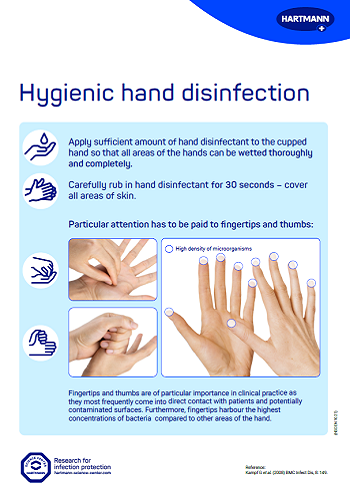Modes of Transmission

Many patients wish that their physicians would actively involve them in therapy decisions. And many physicians comply with this wish with the approach of a shared decision-making (SDM). In this approach, physicians and patients take any decision on the medical therapy jointly and as equal partners. Prerequisite for this is a fundamental understanding of the own health: today—thanks to Google, medical forums, etc.—the “empowered patient” is more competent than ever. But to anticipate fears and misinformation it is reasonable to establish a targeted patient empowerment in the medical field. When physicians, health organisations and medical facilities provide their patients with selected and well-founded information, they promote their health competence and ensure enlightened decisions.
The added value of patient empowerment is not limited to the decisions on therapy and treatment—also in hand hygiene, active patient empowerment is a useful addition for patient safety and infection control. The reason: without any doubt, hand hygiene is the most important measure to prevent nosocomial infection. However, educational campaigns and training courses mainly address healthcare workers. But topics such as prevention and protection against infections increasingly attract the attention of patients as well: according to a survey, 81 % of Germans are afraid of acquiring a multidrug-resistant pathogen during their hospital stay [1]. To involve patients in hand hygiene in a targeted manner can help assess risks of infection in the hospital more realistically and overcome irrational fears of multidrug-resistant microorganisms. However, efficient patient empowerment in hand hygiene also informs patients of the role they play in infection control—and thus encourages them to become active.
For a successful implementation of patient empowerment, acceptance by healthcare staff and patients is required above all. Scientific observations show that this is not always the case [2]: While 49.9 % of patients are willing to remind doctors and nurses to disinfect their hands, only 31.6 % of doctors and nurses support patient empowerment. The reason given by 76 % of the patients is fear of upsetting the nursing staff or receiving worse treatment as a consequence. On the doctors' side, 40 % each state that patients lack sufficient knowledge to make an assessment and that patient involvement in treatment can have negative effects on the relationship between doctor and patient. 58 % of the nursing staff consider patient involvement to be unnecessary.
To learn more about hand hygiene patients especially wish to be directly encouraged by staff (80.8%) and want visual reminders, e.g. posters (73.4%) [2]. When speaking with patients it is important to minimise fears and inspire personal initiative. Example: knowing that bacteria do not develop in hospitals but are naturally present in the environment and even are a vital part on the own intestinal and skin flora helps patients. And the hint that they are allowed to use the disinfectant dispensers installed in the hospital additionally helps overcome potential inhibitions and can promote the hand hygiene behaviour of patients and visitors.
The moments when patients and visitors should disinfect their hands are derived from the recommendations of the World Health Organization (WHO) and the German Robert Koch-Institute (RKI) [3, 4]:
